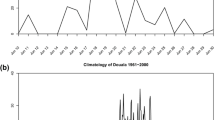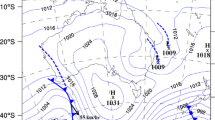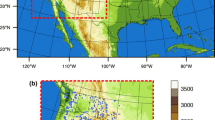Abstract
The Weather Research and Forecasting (WRF) model is used to simulate the spatiotemporal distribution of precipitation over central Asia over the year April 2005 through March 2006. Experiments are performed at 6.7 km horizontal grid spacing, with an emphasis on winter and summer precipitation over the Himalaya. The model and the Tropical Rainfall Measuring Mission show a similar inter-seasonal cycle of precipitation, from extratropical cyclones to monsoon precipitation, with agreement also in the diurnal cycle of monsoon precipitation. In winter months, WRF compares better in timeseries of daily precipitation to stations below than above 3-km elevation, likely due to inferior measurement of snow than rain by the stations, highlighting the need for reliable snowfall measurements at high elevations in winter. In summer months, the nocturnal precipitation cycle in the foothills and valleys of the Himalaya is captured by this 6.7-km WRF simulation, while coarser simulations with convective parameterization show near zero nocturnal precipitation. In winter months, higher resolution is less important, serving only to slightly increase precipitation magnitudes due to steeper slopes. However, even in the 6.7-km simulation, afternoon precipitation is overestimated at high elevations, which can be reduced by even higher-resolution (2.2-km) simulations. These results indicate that WRF provides skillful simulations of precipitation relevant for studies of water resources over the complex terrain in the Himalaya.
















Similar content being viewed by others
References
Anders AM, Roe GH, Hallet B, Montgomery DR, Finnegan NJ, Putkonen J (2006) Spatial patterns of precipitation and topography in the Himalaya. Geol Soc Am Spec Pap 398:39–53
Archer DR, Fowler HJ (2004) Spatial and temporal variations in precipitation in the Upper Indus Basin, global teleconnections and hydrological implications. Hydrol Earth Syst Sci 8:47–61
Bao X, Zhang F (2013) Evaluation of NCEP-CFSR, NCEP-NCAR, ERA-Interim, and ERA-40 reanalysis datasets against independent sounding observations over the Tibetan Plateau. J Clim 26:206–214
Barlow M, Wheeler M, Lyon B, Cullen H (2005) Modulation of daily precipitation over southwest Asia by the Madden–Julian Oscillation. Mon Weather Rev 133:3579–3594
Barnett TP, Adam JC, Lettenmaier DP (2005) Potential impacts of a warming climate on water availability in snow-dominated regions. Nature 438:303–309
Barros AP, Lang TJ (2003) Monitoring the monsoon in the Himalayas: observations in central Nepal, June 2001. Mon Weather Rev 131:1408–1427
Barros AP, Chiao S, Lang TJ, Burbank D, Putkonen J (2006) From weather to climate-seasonal and interannual variability of storms and implications for erosion processes in the Himalaya. Geol Soc Am Spec Pap 398:17–38
Bollasina M, Bertolani L, Tartari G (2002) Meteorological observations at high altitude in the Khumbu Valley, Nepal Himalayas, 1994–1999. Bull Glaciol Res 19:1–11
Bonasoni P, Laj P, Angelini F, Arduini J, Bonafè U, Calzolari F, Cristofanelli P, Decesari S, Facchini MC, Fuzzi S, Gobbi GP, Maione M, Marinoni A, Petzold A, Roccato F, Roger JC, Sellegri K, Sprenger M, Venzac H, Verza GP, Villani P, Vuillermoz E (2008) The ABC-Pyramid Atmospheric Research Observatory in Himalaya for aerosol, ozone and halocarbon measurements. Sci Total Environ 391:252–261
Bookhagen B, Thiede RC, Strecker MR (2005) Abnormal monsoon years and their control on erosion and sediment flux in the high, arid northwest Himalaya. Earth Planet Sci Lett 231:131–146
Bookhagen B, Burbank DW (2006) Topography, relief, and TRMM-derived rainfall variations along the Himalaya. Geophys Res Lett 33:L08405. doi:10.1029/2006GL026037
Bookhagen B, Burbank DW (2010) Towards a complete Himalayan hydrological budget: the spatiotemporal distribution of snowmelt and rainfall and their impact on river discharge. J Geophys Res 115:F03019
Collier E, Immerzeel WW (2015) High-resolution modeling of atmospheric dynamics in the Nepalese Himalaya. J Geophys Res 120(19):9882–9896
Cannon F, Carvalho LMV, Jones C, Hoell A, Norris J, Kiladis GN, Tahir AA (2016) The influence of tropical forcing on extreme winter precipitation in the western Himalaya. Dyn Clim. doi:10.1007/s00382-016-3137-0
Carvalho LMV, Jones C, Cannon F, Norris J (2016) Intraseasonal-to-interannual variability of the Indian monsoon identified with the Large-scale Index for the Indian Monsoon System (LIMS). J Clim 29:2941–2962
Curio J, Maussion F, Scherer D (2015) A 12-year high-resolution climatology of atmospheric water transport over the Tibetan Plateau. Earth Syst Dyn 6:109–124
Dimri AP, Chevaturi A (2014) Model sensitivity analysis study for western disturbances over the Himalayas. Meteorol Atmos Phys 123:155–180
Fowler HJ, Archer DR (2006) Conflicting signals of climate change in the Upper Indus Basin. J Clim 19:4276–4293
Ghimire S, Choudhary A, Dimri AP (2015) Assessment of the performance of CORDEX-South Asia experiments for monsoonal precipitation over the Himalayan region during present climate: part I. Dyn Clim. doi:10.1007/s00382-015-2747-2
Hewitt K, Wake CP, Young GJ, David C (1989) Hydrological investigations at Biafo Glacier. Karakoram Himalaya: an important source of water for the Indus River. Ann Glaciol 13:103–108
Hewitt K (2011) Glacier change, concentration, and elevation effects in the Karakoram Himalaya, Upper Indus Basin. Mt Res Dev 31:188–200
Hewitt K (2014) Glaciers of the Karakoram Himalaya: Glacial environments, processes, hazards and resources. Springer, Dordrecht
Hong S-Y, Noh Y, Dudhia J (2006) A new vertical diffusion package with an explicit treatment of entrainment processes. Mon Weather Rev 134:2318–2341
Houze RA Jr, Wilton DC, Smull BF (2007) Monsoon convection in the Himalayan region as seen by the TRMM precipitation radar. Q J R Meteorol Soc 133:1389–1411
Huffman GJ, Adler RF, Bolvin DT, Gu G, Nelkin EJ, Bowman KP, Hong Y, Stocker EF, Wolff DB (2007) The TRMM multisatellite precipitation analysis (TMPA): quasi-global, multiyear, combined-sensor precipitation estimates at fine scales. J Hydrometeorol 8:38–55
Iacono MJ, Delamere JS, Mlawer EJ, Shephard MW, Cloud SA, Collins WD (2008) Radiative forcing by long-lived greenhouse gases: calculations with the AER radiative transfer models. J Geophys Res 113:D13103, 8
Immerzeel WW, Bierkens MFP (2012) Asia’s water balance. Nat Geosci 5:841–842
Immerzeel WW, Pellicciotti F, Bierkens MFP (2013) Rising river flows throughout the twenty-first century in two Himalayan glacierized watersheds. Nat Geosci 6:742–745
Jones C (2009) A homogeneous stochastic model of the Madden Julian oscillation. J Clim. 22:3270–3288
Kain JS (2004) The Kain-Fritsch convective parameterization: an update. J Appl Meteorol 43:170–181
Kapnick SB, Delworth TL, Ashfaq M, Malyshev S, Milly PCD (2014) Snowfall less sensitive to warming in Karakoram than in Himalayas due to a unique seasonal cycle. Nat Geosci 7:834–840
Kurosaki Y, Kimura F (2002) Relationship between topography and daytime cloud activity around Tibetan Plateau. J Meteorol Soc Jpn 80:1339–1355
Lang TJ, Barros AP (2004) Winter storms in the Central Himalayas. J Meteor Soc Jpn 82:829–844
Li M, Ma Y, Hu Z, Ishikawa H, Oku Y (2009) Snow distribution over the Namco lake area of the Tibetan Plateau. Hydrol Earth Syst Sci 13:2023–2030
Lutz AF, Immerzeel WW, Shrestha AB, Bierkens MFP (2014) Consistent increase in High Asia’s runoff due to increasing glacier melt and precipitation. Nat Clim Change 4:587–592
Maussion F, Scherer D, Finkelnburg R, Richters J, Yang W, Yao T (2011) WRF simulation of a precipitation event over the Tibetan Plateau, China: an assessment using remote sensing and ground observations. Hydrol Earth Syst Sci 15:1795–1817
Maussion F, Scherer D, Mölg T, Collier E, Curio J, Finkelnburg R (2014) Precipitation seasonality and variability over the Tibetan Plateau as resolved by the High Asia Reanalysis. J Clim 27:1910–1927
Medina S, Houze RA Jr, Kumar A, Niyogi D (2010) Summer monsoon convection in the Himalayan region: terrain and land cover effects. Q J R Meteorol Soc 136:593–616
Monin AS, Obukhov AM (1954) Basic laws of turbulent mixing in the surface layer of the atmosphere. Tr Akad Nauk SSSR Geofiz Inst 24(151):163–187
Niu G-Y, Yang Z-L, Mitchell KE, Chen F, Ek MB, Barlage M, Kumar A, Manning K, Niyogi D, Rosero E, Tewari M, Xia Y (2011) The community Noah land surface model with multiparameterization options (NoahMP): 1. Model description and evaluation with localscale measurements. J Geophys Res 116:D12109, 19
Norris J, Carvalho LMV, Jones C, Cannon F (2015) WRF simulations of two extreme snowfall events associated with contrasting extratropical cyclones over the western and central Himalaya. J Geophys Res 120:3114–3138
Palazzi E, Tahir AA, Cristofanelli P, Vuillermoz E, Provenzale A (2015) Climatic characterization of Baltoro Glacier (Karakoram) and northern Pakistan from in-situ stations. Eng Geol Soc Territ 1:33–37
Putkonen JK (2004) Continuous snow and rain data at 500–4400 m altitude near Annapurna, Nepal, 1999–2001. Arct Antarct Alp Res 36(2):244–248
Rasmussen R, Liu C, Ikeda K, Gochis D, Yates D, Chen F, Tewari M, Barlage M, Dudhia J, Yu W, Miller K (2011) High-resolution coupled climate runoff simulations of seasonal snowfall over Colorado: a process study of current and warmer climate. J Clim 24:3015–3048
Saha S, Moorthi S, Pan H-L, Wu X, Wang J, Nadiga S, Tripp P, Kistler R, Woollen J, Behringer D, Liu H, Stokes D, Grumbine R, Gayno G, Wang J, Hou Y-T, Chuang H-Y, Juang H-MH, Sela J, Iredell M, Treadon R, Kleist D, Van Delst P, Keyser D, Derber J, Ek M, Meng J, Wei H, Yang R, Lord S, van den Dool H, Kumar A, Wang W, Long C, Chelliah M, Xue Y, Huang B, Schemm J-K, Ebisuzaki W, Lin R, Xie P, Chen M, Zhou S, Higgins W, Zou C-Z, Liu Q, Chen Y, Han Y, Cucurull L, Reynolds RW, Rutledge G, Goldberg M (2010) The NCEP climate forecast system reanalysis. Bull Am Meteorl Soc, pp 1015–1057. doi:10.1175/2010BAMS3001.1
Sato T, Yoshikane T, Satoh M, Miura H, Fujinami H (2008) Resolution dependency of the diurnal cycle of convective clouds over the Tibetan Plateau in a mesoscale model. J Meteorol Soc Jpn 86A:17–31
Sato T (2013) Mechanism of orographic precipitation around the Meghalaya Plateau associated with intraseasonal oscillation and the diurnal cycle. Mon Weather Rev 141:2451–2466
Scientia Sinica (1979) The Batura Glacier in the Karakoram Mountains and its variations. 22:958–974
Scherler D, Bookhagen B, Strecker MR (2011) Spatially variable response of Himalayan glaciers to climate change affected by debris cover. Nat Geosci 4:156–159
Skamarock WC, Klemp JB, Dudhia J, Gill DO, Barker DM, Duda MG, Huang X-Y, Wang W, Powers JG (2008) A Description of the Advanced Research WRF Version 3. NCAR Technical Note NCAR/TN–475+STR. NCAR, Boulder, CO
Stauffer DR, Seaman NL (1990) Use of four-dimensional data assimilation in a limited-area mesoscale model. Part I: experiments with synoptic-scale data. Mon Weather Rev 118:1250–1277
Stauffer DR, Seaman NL, Binkowski FS (1991) Use of four-dimensional data assimilation in a limited-area mesoscale model. Part II: effects of data assimilation within the planetary boundary layer. Mon Weather Rev 119:734–754
Tahir AA, Chevallier P, Arnaud Y, Ahmad B (2011) Snow cover dynamics and hydrological regime of the Hunza River basin, Karakoram Range, Northern Pakistan. Hydrol Earth Syst Sci 15:2275–2290
Thomas L, Dash SK, Mohanty UC (2014) Influence of various land surface parameterization schemes on the simulation of Western disturbances. Meteorol Appl 21:635–643
Thompson G, Field PR, Rasmussen RM, Hall WD (2008) Explicit forecasts of winter precipitation using an improved bulk microphysics scheme. Part II: implementation of a new snow parameterization. Mon Weather Rev 136:5095–5115
Ueno K, Toyotsu K, Bertolani L, Tartari G (2008) Stepwise onset of monsoon weather observed in the Nepal Himalaya. Mon Weather Rev 136:2507–2522
Vano JA, Udall B, Cayan DR, Overpeck JT, Brekke LD, Das T, Hartmann HC, Hidalgo HG, Hoerling M, McCabe GJ, Morino K, Webb RS, Werner K, Lettenmaier DP (2014) Understanding uncertainties in future Colorado River streamflow. Bull Am Meteor Soc, pp 59–78. doi:10.1175/BAMS-D-12-00228.1
Wake CP (1989) Glaciochemical investigations as a tool to determine the spatial variation of snow accumulation in the central Karakoram, northern Pakistan. Ann Glaciol 13:279–284
Wulf H, Bookhagen B, Scherler D (2010) Seasonal precipitation gradients and their impact on fluvial sediment flux in the Northwest Himalaya. Geomorphology 118:13–21
Yang X, Fei J, Huang X, Cheng X, Carvalho LMV, He H (2015) Characteristics of mesoscale convective systems over China and its vicinity using geostatioinary satellite FY2. J Clim 28:4890–4907
Yasutomi N, Hamada A, Yatagai A (2011) Development of a long-term daily gridded temperature dataset and its application to rain/snow discrimination of daily precipitation. Glob Environ Res 15(2):165–172
Yatagai A, Kamiguchi K, Arakawa O, Hamada A, Yasutomi N, Kitoh A (2012) APHRODITE: constructing a long-term daily gridded precipitation dataset for Asia based on a dense network of rain gauges. Bull Am Meteorol Soc, pp 1401–1415. doi:10.1175/BAMS-D-11-00122.1
Acknowledgements
This research was supported by the Climate and Large-scale Dynamics Program, from the National Science Foundation (NSF award-AGS 1116105) and by the U.S. National Aeronautics and Space Administration (NASA) Headquarters under the NASA Earth and Space Science Fellowship Program (Grant Number 13-EARTH13F-26). The CFSR data used in this research were developed by NCEP and provided by the National Center for Atmospheric Research (NCAR), available at http://rda.ucar.edu/pub/cfsr.html. TRMM data were acquired by an international joint project sponsored by the Japan National Space Development Agency (NASDA) and the NASA Office of Earth Science, available at http://trmm.gsfc.nasa.gov. High-performance computing support from Yellowstone (ark:/85065/d7wd3xhc) was provided by NCAR’s Computational and Information Systems Laboratory (CISL), sponsored by the NSF. Thanks to the anonymous reviewers whose comments have greatly improved our manuscript.
Author information
Authors and Affiliations
Corresponding author
Rights and permissions
About this article
Cite this article
Norris, J., Carvalho, L.M.V., Jones, C. et al. The spatiotemporal variability of precipitation over the Himalaya: evaluation of one-year WRF model simulation. Clim Dyn 49, 2179–2204 (2017). https://doi.org/10.1007/s00382-016-3414-y
Received:
Accepted:
Published:
Issue Date:
DOI: https://doi.org/10.1007/s00382-016-3414-y




